Mauna Loa Carbon Dioxide Record
- Global Scale Experiment
- Atmospheric Co2
- Mauna Loa Measurements
- Longest Continuous Record
- NOAA Scientists and Technicians
An Atmospheric "Experiment" on a Global Scale
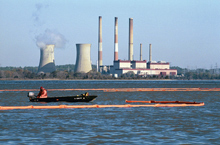
Living organisms produce carbon dioxide as part of the natural process of obtaining energy. Burning coal, oil, and natural gas for energy, as at this power plant, produces carbon dioxide as a by-product of combustion which is then emitted into the atmosphere. Click image for larger view.
In the mid-1950s, a growing awareness among scientists led them to reason that accelerated burning of fossil fuels (coal, oil, and natural gas) had the potential to alter the Earth’s climate on an unprecedented scale by greatly increasing the amount of atmospheric carbon dioxide. Roger Revelle of the Scripps Institution of Oceanography was among the first to recognize this and wrote, “human beings are now carrying out a large-scale geophysical experiment of a kind that could not have happened in the past nor be reproduced in the future.” Revelle declared, “This experiment, if adequately documented, may yield a far-reaching insight into the processes determining weather and climate. It therefore becomes of prime importance to attempt to determine the way in which carbon dioxide is partitioned between the atmosphere, the oceans, the biosphere and the lithosphere.”
Carbon dioxide is a naturally occurring, colorless, odorless gas that makes up less than one-tenth of one percent of the Earth’s atmosphere. It is also a man-made by-product of fossil fuel combustion. Carbon dioxide is one of a number of chemical compounds in the atmosphere along with water vapor, methane, nitrous oxides, and others that are known as “greenhouse gases.” These gases trap the solar energy that radiates back toward space from the Earth’s surface, similar to the effect of the glass panes of a greenhouse, causing the lower atmosphere to warm.
Studying Atmospheric Carbon Dioxide
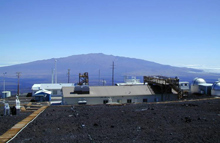
The primary site for the Mauna Loa Observatory and its carbon dioxide sampling equipment is located at the 11,000 ft level on the island of Hawaii. The Weather Bureau founded the observatory in 1956 to gain access to clean, particle-free air when it could not find a suitable site in the continental U.S. Click image for larger view.
Several factors converged in the mid- to late 1950s that encouraged atmospheric scientists to study carbon dioxide distribution. One was declaration of the International Geophysical Year (IGY) in 1957-1958; another was the serendipitous construction of a new atmospheric observatory high on the slope of Mauna Loa, Hawaii, by the United States Weather Bureau in 1956; a third was the interest and patronage of Harry Wexler and Robert Simpson of the Weather Bureau and the passion of Dr. Charles “Dave” Keeling of California Institute of Technology to learn more about atmospheric carbon dioxide.
Keeling came to Wexler’s attention and traveled to Washington in 1956 to discuss a continuous carbon dioxide measurement system. This fit into Wexler’s plans to monitor carbon dioxide and also to use the new Mauna Loa Observatory for a suite of observations during the IGY. In the meantime, Keeling attracted Revelle who invited him to Scripps to establish an atmospheric carbon dioxide laboratory and begin continuous measurement operations. Continuous carbon dioxide monitoring represented a break from the conventional wisdom in the early 1950s. Then, scientists believed a few measurements at a few places around the earth every few years would suffice for understanding global atmospheric carbon dioxide. Researchers soon abandoned this approach when they were unable to discern patterns or trends in their sporadic observations.
Mauna Loa Measurements Begin in 1958
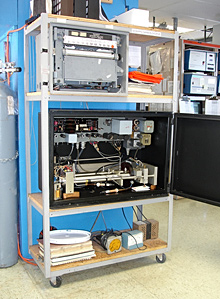
The Scripps Institution of Oceanography (Keeling) carbon dioxide analyzer at NOAA’s Mauna Loa Observatory. The analyzer (center) was installed in March 1958. It used radio tubes and collected carbon dioxide data in its original configuration until its decommissioning in January 2006. The original strip chart recorder (top) also operated from 1958 until 2006. John Chin of the Mauna Loa staff faithfully tended the analyzer from 1963 to 2004. The Observatory now maintains the instrument as a museum piece at its original location. Click image for larger view.
After setting up the Scripps laboratory and acquiring equipment for remote observatories with funding from international geophysical year grants, Keeling initiated carbon dioxide measurements at the Mauna Loa Observatory in March 1958 with operational support provided by personnel and facilities of the U.S. Weather Bureau. The Weather Bureau and NOAA have supported carbon dioxide data gathering efforts at Mauna Loa ever since, except for a brief period in 1964 when government-wide funding and personnel cutbacks prevented staff from maintaining the measuring equipment. Within a few years of initiating the continuous Mauna Loa carbon dioxide measurements, the annual increase in the atmospheric concentrations of carbon dioxide became apparent.
In 1974, NOAA instituted a global program of monitoring carbon dioxide and other atmospheric gases under the direction of Dr. Lester Machta. The Mauna Loa Observatory installed a new carbon dioxide analyzer system at the time that operated in parallel with the Scripps analyzer. In December 2006, Scripps replaced its original analyzer, which had been upgraded over its 48 years of service, with a new one following a year of overlapping carbon dioxide sampling between its two instruments to assure continuity of the data.
The NOAA and Scripps carbon dioxide analyzers, operating together at Mauna Loa, provide important redundancy of measurements. This is crucial to maintaining the integrity of the Mauna Loa carbon dioxide record and the entire global carbon dioxide measurement network. Besides sampling the air at its existing stations on Mauna Loa and at the South Pole, NOAA built and developed sampling stations at new observatories in *Barrow, Alaska (1973) and** in American Samoa (1974) where it continues to measure atmospheric carbon dixoide.
Longest Continuous Record of Atmospheric Carbon Dioxide
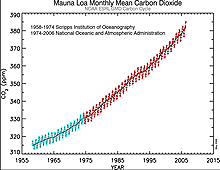
This simple graph of the Mauna Loa Carbon Dioxide Record documents a 0.53 percent or two parts per million per year increase in atmospheric carbon dioxide since 1958. This gas alone is responsible for 63 percent of the warming attributable to all greenhouse gases according to NOAA's Earth System Research Lab. Click image for larger view.
The Mauna Loa Carbon Dioxide Record is the longest continuous record of atmospheric concentrations of carbon dioxide, the chief greenhouse gas responsible for global climate warming. It is often called the most important geophysical record on Earth and has been instrumental in showing that mankind is changing the composition of the atmosphere through the combustion of fossil fuels. This, in turn, formed the basis for the theory of global atmospheric change through heating of the Earth’s atmosphere.
Climate scientists and climate modelers from around the world use the Mauna Loa data to project the state of the Earth’s future climate. Each year the Mauna Loa Observatory announces the increasing concentration of atmospheric carbon dioxide. The Kyoto Protocol, an agreement by the majority of the nations to control the future rate of carbon dioxide increase in the atmosphere, was an outcome of the Mauna Loa carbon dioxide measurements.
Dedicated NOAA Scientists and Technicians
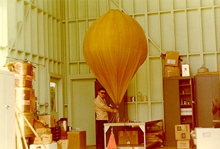
Dr. Charles Keeling, who began continuous atmospheric carbon dioxide monitoring at Mauna Loa Observatory in 1958, credits long-time NOAA employee John Chin, shown here in 1970, as the individual most responsible for maintaining the long-term observations.
Although NOAA scientists and technicians have now monitored carbon dioxide and other atmospheric gases worldwide for many years, perhaps Charles Keeling in his 1998 autobiography best epitomizes the role of dedicated NOAA personnel in helping build the Mauna Loa Carbon Dioxide Record, referred to also as the ‘Keeling Curve:’ “I express my appreciation to …. John Chin of NOAA, recruited for work at Mauna Loa, who has taken care of our equipment at Mauna Loa ever since the budget crisis of 1963, and is probably more directly responsible than anyone else for creating the Mauna Loa carbon dioxide curve that has been credited to me.” John Chin, a physicist at the Mauna Loa Observatory, retired from NOAA in 2000 after 37 years of service at the Observatory. During that period he made over 6,000 automobile round-trips to the Observatory from Hilo, Hawaii, a distance equivalent of 25 trips around the Earth!










